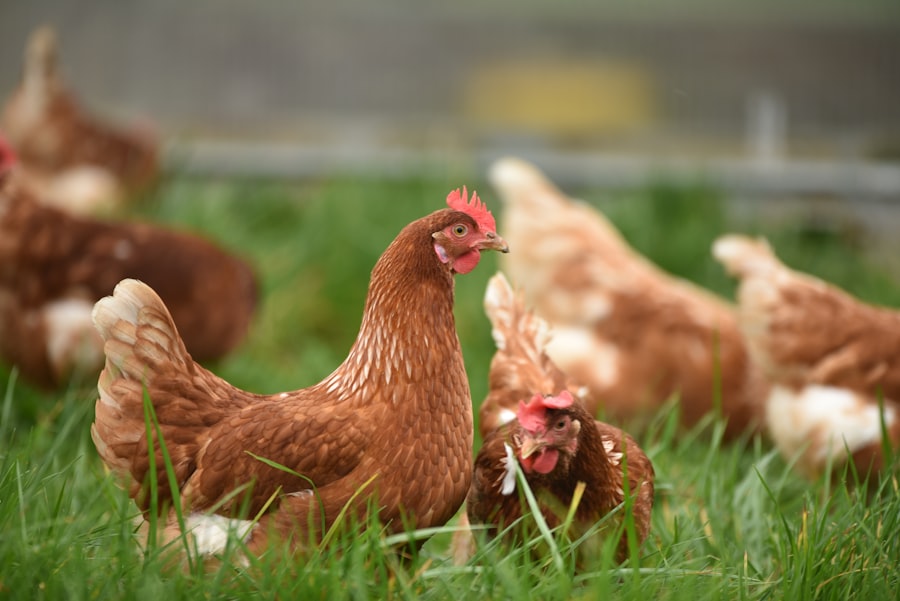Blue light therapy is a relatively new concept in the world of chicken farming, but it is quickly gaining popularity due to its numerous benefits for chicken health and behavior. Blue light therapy involves exposing chickens to a specific wavelength of blue light, which has been shown to have positive effects on their well-being. This therapy can be implemented by installing blue light fixtures in the chicken coop, providing a controlled environment for the chickens to receive the necessary exposure.
Key Takeaways
- Blue light therapy can improve the health and happiness of chickens.
- Blue light can help keep chickens calm and reduce stress.
- The recommended exposure time for blue light therapy is 14-16 hours per day.
- Blue light fixtures can be easily installed in chicken coops.
- While there is a cost to implementing blue light therapy, the benefits for chicken health and productivity may outweigh the expense.
Understanding the Benefits of Blue Light for Chickens
Blue light therapy has been found to have several benefits for chickens. One of the most significant benefits is improved egg production. Studies have shown that chickens exposed to blue light produce more eggs compared to those not exposed to it. This increase in egg production can be attributed to the regulation of melatonin levels in the chickens’ bodies. Melatonin is a hormone that plays a crucial role in regulating sleep and wake cycles, and exposure to blue light helps regulate its production.
In addition to improved egg production, blue light therapy also helps reduce stress levels in chickens. Stress can have a negative impact on chicken health and can lead to decreased egg production, decreased immune function, and even increased mortality rates. By providing a calming environment through blue light therapy, chickens experience reduced stress levels, leading to overall better health and well-being.
How Blue Light Therapy Helps Keep Chickens Calm
Blue light therapy helps keep chickens calm by regulating their behavior and reducing stress levels. Chickens are naturally diurnal animals, meaning they are active during the day and rest at night. However, artificial lighting in chicken coops can disrupt their natural sleep-wake cycles, leading to increased stress levels.
Exposure to blue light helps regulate the production of melatonin in chickens, which in turn helps regulate their sleep-wake cycles. By providing a consistent and controlled environment with blue light therapy, chickens are able to maintain their natural behavior patterns and experience reduced stress levels. This can have a significant impact on their overall health and well-being.
The Science Behind Blue Light and Chicken Behavior
The science behind blue light therapy lies in its impact on the production of melatonin and serotonin in chickens. Melatonin is a hormone that regulates sleep and wake cycles, while serotonin is a neurotransmitter that plays a role in mood regulation. Exposure to blue light has been found to suppress the production of melatonin and increase the production of serotonin in chickens.
By regulating the production of these hormones, blue light therapy helps keep chickens calm and reduces stress levels. This can have a positive impact on their behavior, as well as their overall health and well-being. The science behind blue light therapy provides a solid foundation for its implementation in chicken coops.
Installing Blue Light Fixtures in Your Chicken Coop
Installing blue light fixtures in your chicken coop is a relatively simple process that can have significant benefits for your chickens. There are several types of fixtures available, including LED lights and fluorescent lights. LED lights are energy-efficient and long-lasting, making them a popular choice among chicken farmers. Fluorescent lights are also commonly used and provide a good source of blue light.
When installing blue light fixtures, it is important to consider the size of your chicken coop and the number of chickens you have. It is recommended to have one fixture for every 100 square feet of coop space. This ensures that all chickens receive adequate exposure to the blue light therapy.
Recommended Blue Light Exposure Time for Chickens

The recommended exposure time for blue light therapy can vary depending on factors such as the age and breed of the chickens. Generally, it is recommended to provide 14-16 hours of blue light exposure per day for adult chickens. For younger chickens, such as chicks or pullets, it is recommended to provide 18-20 hours of exposure per day.
It is important to note that blue light therapy should be provided consistently and at the same time each day to maintain the chickens’ natural sleep-wake cycles. This helps regulate their behavior and reduce stress levels. It is also important to provide a period of darkness for the chickens to rest and sleep.
The Best Time of Day to Use Blue Light Therapy for Chickens
The best time of day to use blue light therapy for chickens can vary depending on the season and the age of the chickens. During the winter months when daylight hours are shorter, it is recommended to provide blue light therapy in the morning and evening to extend the chickens’ exposure to light.
During the summer months when daylight hours are longer, it is recommended to provide blue light therapy in the early morning and late evening, allowing the chickens to have a period of darkness during the night. This helps maintain their natural sleep-wake cycles and ensures they receive adequate exposure to blue light.
The Cost of Implementing Blue Light Therapy in Your Chicken Coop
The cost of implementing blue light therapy in your chicken coop can vary depending on several factors. The size of your coop and the number of chickens you have will determine how many fixtures you need, which will impact the overall cost. Additionally, the type of fixtures you choose, such as LED lights or fluorescent lights, can also affect the cost.
On average, the cost of installing blue light fixtures in a chicken coop can range from $100 to $500, depending on the size and type of fixtures. While this may seem like a significant investment, the long-term benefits for chicken health and well-being make it a worthwhile expense.
Other Benefits of Blue Light Therapy for Chickens
In addition to improved egg production and reduced stress levels, blue light therapy has been found to have other potential benefits for chickens. Studies have shown that exposure to blue light can improve immune function in chickens, leading to reduced mortality rates and better overall health.
Blue light therapy has also been found to have a positive impact on the growth and development of chickens. It can help regulate their appetite and promote healthy weight gain. This can be particularly beneficial for commercial chicken farmers who rely on the growth and development of their chickens for profit.
Improving Chicken Health and Happiness with Blue Light Therapy
Blue light therapy is a promising new approach to improving chicken health and happiness. By providing a controlled environment with blue light fixtures, chickens can experience improved egg production, reduced stress levels, and overall better health. The science behind blue light therapy provides a solid foundation for its implementation in chicken coops.
If you are a chicken farmer or enthusiast, it is worth considering implementing blue light therapy in your own chicken coop. The benefits for chicken health and well-being are significant, and the cost of installation is relatively affordable. By providing a calming environment with blue light therapy, you can improve the health and happiness of your chickens, leading to better overall productivity and satisfaction.
If you’re interested in learning more about keeping chickens calm, you might find this article on the Poultry Wizard website helpful. It discusses the benefits of using blue light to create a calming environment for chickens. Blue light has been found to reduce stress and promote relaxation in chickens, making it an effective tool for chicken owners. To read more about this topic, check out the article here.
FAQs
What is blue light?
Blue light is a type of light with a wavelength between 450 and 490 nanometers. It is a part of the visible light spectrum and is known to have a stimulating effect on the brain.
How does blue light affect chickens?
Blue light has been found to have a calming effect on chickens. It can reduce stress levels and improve their overall well-being.
Why is it important to keep chickens calm?
Stressed chickens are more susceptible to illness and disease, which can lead to decreased egg production and even death. Keeping chickens calm can improve their health and productivity.
How can blue light be used to keep chickens calm?
Blue light can be used in chicken coops to create a calming environment. It can be installed in the form of LED lights or natural light from windows. The blue light should be on for at least 16 hours a day to have a noticeable effect.
Are there any risks associated with using blue light in chicken coops?
There are no known risks associated with using blue light in chicken coops. However, it is important to ensure that the chickens have access to natural light as well and that the blue light is not too bright, as this can disrupt their sleep patterns.
Meet Walter, the feathered-friend fanatic of Florida! Nestled in the sunshine state, Walter struts through life with his feathered companions, clucking his way to happiness. With a coop that’s fancier than a five-star hotel, he’s the Don Juan of the chicken world. When he’s not teaching his hens to do the cha-cha, you’ll find him in a heated debate with his prized rooster, Sir Clucks-a-Lot. Walter’s poultry passion is no yolk; he’s the sunny-side-up guy you never knew you needed in your flock of friends!







